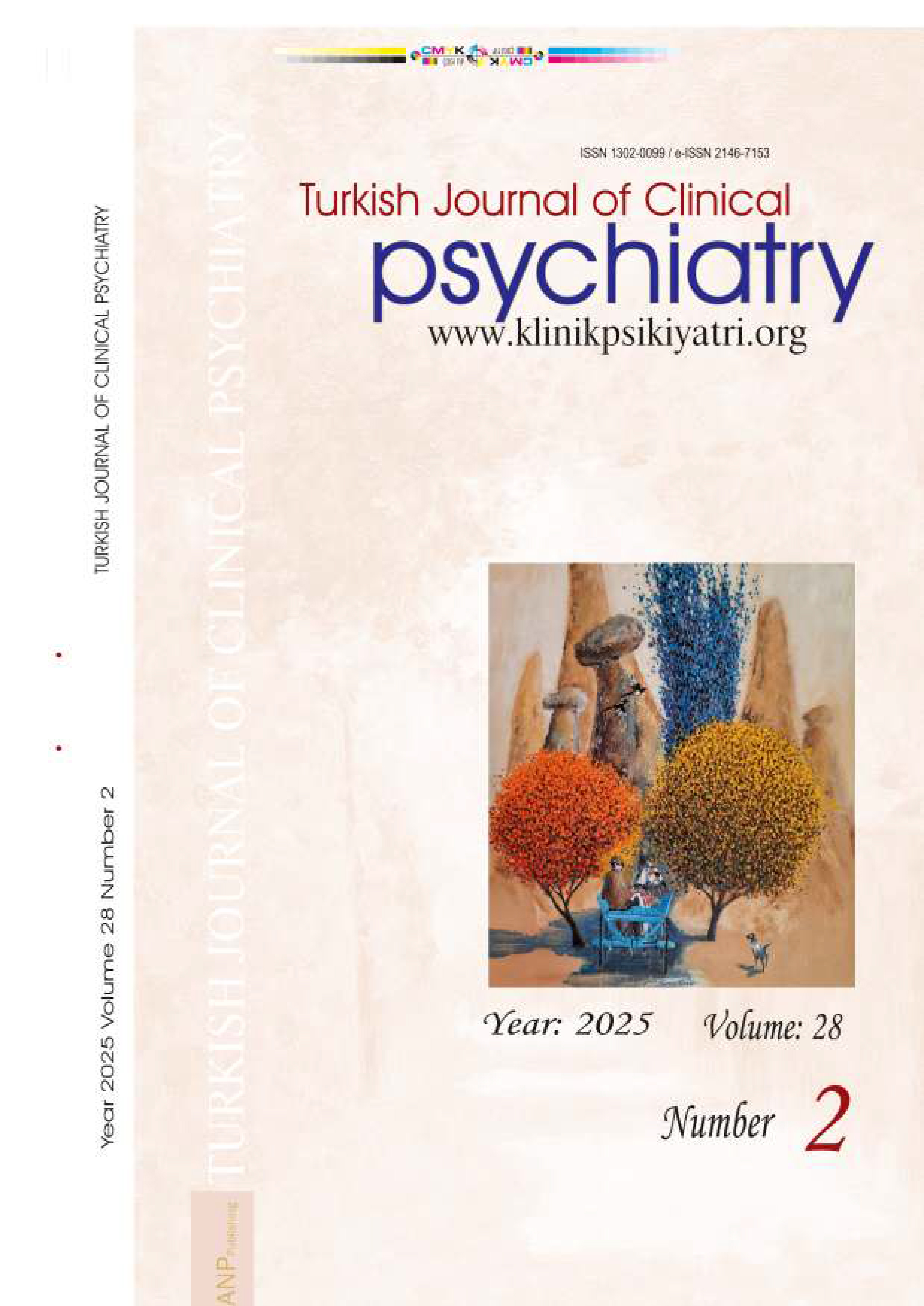





Volume: 14 Issue: 2 - 2011
| RESEARCH ARTICLE | |
| 1. | Conners-Wells' Adolescent Self-Report Scale-Long Form: Evaluation Psychometric Properties for Turkish Adolescents Sema Kaner, Şener Büyüköztürk, Elvan İşeri, Aylin Ak, Latife Özaydın Pages 71 - 84 Objectives: Purpose of this study was to provide Turkish version and investigate psychometric properties of the Conners-Wells' Adolescent Self-Report Scale-Long Form- CASS-L. Method: By the means of multistage sampling 1898 children and adolescents aged 12-17 years old were enrolled in this study and confirmatory factor analysis was performed for their responses to CASS-L form. The structure validity of the scale was also investigated by the correlations between subscales, item analysis, and the comparison of known groups. To evaluate criterion validity the correlation with Conners' Teacher Rating Scale- Revised/Long-CTRS-R/L, Conners' Parent Rating Scale-Revised/Long. CPRS-R/L, Beck Depression Scale, and State-Trait Anxiety Inventory were conducted. Internal reliability of CASS-L was measured with Cronbach's alpha coefficient and Spearman-Brown split half coefficient, and test-retest reliability was also investigated. Results: Confirmatory factor analysis suggested that CASS-L CPRS-R/L form's structure derived from Turkish children were fit to the original structure of the scale except one item. Conclusion: It was concluded that besides the other information sources, the Turkish form of CASS-L is a valid and reliable instrument based on adolescents' reports and can be use to determining the effects of treatment. However, CASS-L1 structure validity must be investigated on the adolescents with different types of ADHD and different psychiatric diagnosis. |
| 2. | Female Sexual Disfunction and Evaluation of the Related Sociocultural Parameters in a General Psychiatric Outpatient Clinic Derya Güliz Mert, Nurper Erberk Özen Pages 85 - 93 Objectives: In this study we aimed to find out the prevalence of female sexual disfunction (FSD) and the sociocultural factors influencing it among at least one year old married women who applied to Kirikkale University Faculty of Medicine Psychiatry Outpatient Clinic by taking appointment with complaints different from female sexual dysfunction. Method: The data for investigation were collected through three distict questionnaires and face to face interview is used. For the diagnosis of DSM- IV axis I disorder SCID (Structured Clinical Interview for DSM-IV) were applied. To diagnose sexual disorder, complaints of sexual function has been questioned to detailed regardless of axis I disorder. In questionnaires filled out by patients, sociocultural factors and sociodemographic haracteristics were investigated. To assess FSD, Female Sexual Function Index (FSFI) is used. Results: The mean age of the participating women was 35.9±8.6 years. 93% of the women were housewife and 50% of education level was primary school. They had been married for 16.6±8.6 years on average. The prevalence of FSD was 36.2% among the married women of 20-74 of age. The factors affecting the sexual dysfunction were as follows: the way of learning the first sexual information, the form of marriage, family attitudes towards sexuality. Conclusion: In this study we find out that the frequency of FSD was consistent with the literature. For the diagnosis of sexual disorders face to face interview should be done because scale used for sexual disorders can only figure out the presence and the severity of sexual problems. According to the results of this study sociocultural structure can affect the sexual life can say. |
| 3. | Are Offenses Involving Violent Behaviour Predictable? A Prison Study Which Perforned on Male Offenders Hüseyin Güleç, Medine Yazıcı Güleç, Semra Ulusoy Kaymak, Mürüvvet Topaloğlu, İsmail Ak Pages 94 - 102 Objectives: Violence is an important social problem, which frequently coexist with offense. In this study, sociodemografic, historical and clinical features of the male offenders, and the relationship of these features with violent behaviour and feelings of compunction has been investigated. Method: One hundred and sixteen male offenders were enrolled in the study. Subjects were separated into two groups as violente offenders (42) non-violente offenders (74). Participants' history, sociodemographic data and clinical futures are assessed with a semi-structured interview. Previous violence, age of first violent behavior, relationship instability, employment problems, substance use, self destruction and compunction were asked. Temperemant and Character Inventory, Self Directedness Subscale, general symptom level, Plutchik and van Praag's impulsivity test were applied. Results: Employment problems and young age at first violent incident were more common in violent offenders. In addition, although major mental illnesses in this group were higher, it didn't show statistical significance. Major mental illness in the history and employment problems were predicted violent behavior. None of the variables was predicted compunction. Conclusion: The history of the employment problems, the young age at first violent and the psychiatric disorders are seen to be the risk factor for the violent behavior in the offenders. To create data about the understanding of our population provides a right basic which is necessary for community and psychiatric rehabilitation interventions dealing with prevention of violent and offense. |
| 4. | Seeking for the Perfect: A Research of the Internal World Nilgün Taşkıntuna, Gamze Özçürümez Pages 103 - 114 Objectives: The basic criticism Kohut made to classical psychoanalysis while developing his self psychology theory is that the concepts formed by Freud were based on biological ideas. In Freud's dual drive theory inspired by Darwin, aggression protects individual as an instinctive and inborn drive. According to Kohut, aggression is not a drive but an emotional response to narcissistic injury. It is a symptom of injury rather than a phenomenon itself. It is important to remember this fundamental difference between the two theories while approaching Ms A in terms of self psychology, particularly considering her life being paralyzed by the fear of being attacked as well as her aggression expressed by her behaviors but not acknowledged by herself. Our aim is to present a research of the internal world in-light of self psychology theory. Method: The psychoanalytic psychotherapy is executed on once a week basis for 50 minute sessions during the first year of therapy, followed by twice a week sessions for the last two years. The treatment is still in progress. Results: The obvious ambivalence of Ms A, her dissatisfaction with what she already has, her constant pursuit for perfection until she is frightened by achievement and abandons it, her being unable to experience the pleasure and peace of satisfaction for at least a while and the fact that when she was a child, her mother often left home for undetermined periods of time had been evaluated through Kohut's selfobject concept. Conclusion: Only when the needs of the child is optimally met by her selfobjects, she can be protected from pathological narcissism in her adult life. Otherwise, the self will be damaged and lack coherence. |
| CASE REPORT | |
| 5. | Disappearence of Encopretic Symptoms in Treatment of Attention Deficit- Hyperactivity Disorder with Methyiphenidate Extended Release Medication: Two Case Reports Ömer Faruk Akça Pages 115 - 118 Comorbidity of Attention Deficit Hyperactivity Disorder (ADHD) with other psychiatric disorders is a common condition and frequently causes difficulties in treatment. Also comorbidity of ADHD and encopresis is known to be common. Despite behavioral methods are known to be effective in treatment of encopresis, some psychotropic drugs are stated to be effective in treatment of encopresis in the literature. However, the mechanisms of these drugs in treatment of encopretic symptoms are not known exactly. In this article two boys are presented who admitted to a Child Psychiatry clinic with complains of gaita incontinence and overactivity. After clinical assessment, these boys were diagnosed as encopresis and ADHD. Firstly, short acting methyiphenidate medication was administered to the patients, however, because of need for single dose medication, short acting methyiphenidate treatment was switched to the extended release methyiphenidate in both patients. Despite encopresis symptoms did not change with short acting methyiphenidate, these symptoms disappeared with extended release methyiphenidate treatment and did not recur during four and fifteen months of follow-up. The cases are presented and possible mechanisms of ADHD-encopresis comorbidity and possible mechanisms of effect of extended release methyiphenidate on encopresis are discussed in this article. As a conclusion, searching and treating ADHD symptoms may lead to recovery of encopretic symptoms in patients with ADHD and comorbid encopresis. |
| 6. | A Case Report About ITP Caused By Long Acting Risperidone Usage Gülcan Güleç, Semiha Tufan Temiz, Alev Büyükkınacı Pages 119 - 123 Thrombocytopenia is a rare but dangerous side effect of antipsychotics. Idiopathic thrombocytopenic purpura is a condition which is diagnosed by exclusion of other causes of increase in thrombocyte degredation and decrease in thrombocyte production. If there is no atyp- ic finding, minimal laboratory evaluation is suggested. Before splenectomy, bone marrow evaluation is suggested for patients who are above 40 years, resistant to treatment or have atypic symptoms. Thrombocyte count may be normal in ITP, but there may be increase in megakaryocyte count. In this paper, our aim was to introduce a case of idiopathic thrombocytopenic purpura induced by long-acting risperidone. 28 years old female schizophrenia patient had been treated with 25mg/15 days long acting risperidone injections for the last one year because she was not compliant to her medications. She admitted to hospital after 4-5 days of her last injection,having petechial rash on her arms and legs which spread to her body afterwards and gingival bleedings and she was diagnosed drug induced ITP. Her medication was discontinued and steroid treatment was started, but since her medication was long-acting, her thrombocyte count was low until drug was eliminated from her body. In this case it was seen that, the antipsychotics which have been known to effect thrombocyte functions, may also have serious effects on thrombocyte count. Especially for long acting antpsychotics, it is important to mention that this side effect may have life threatening results. |










